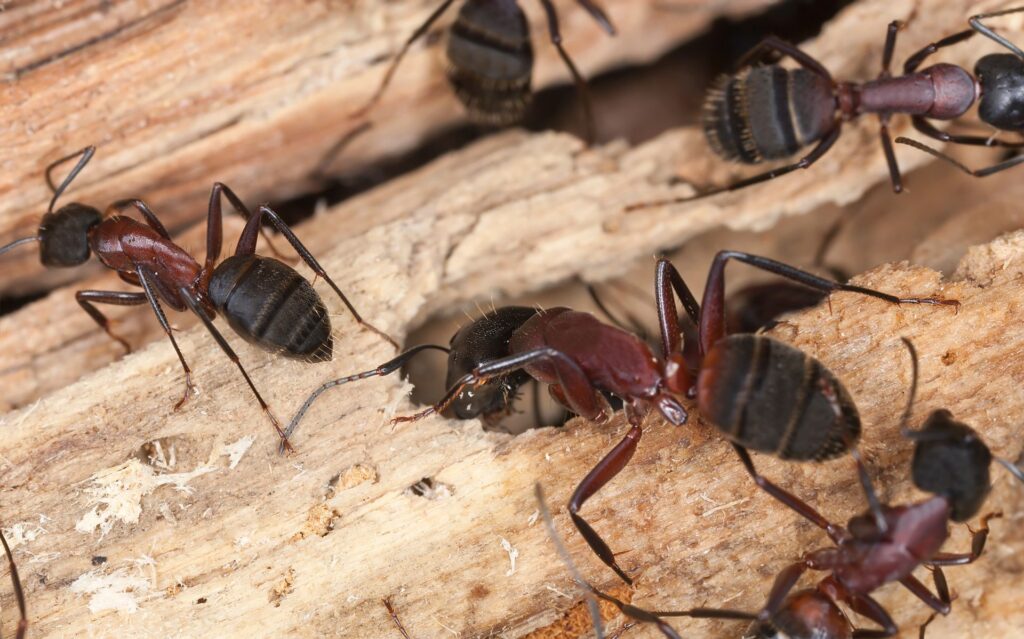Carpenter ants do more than invade your space; they tunnel through wooden beams, floor joists, and wall studs, causing extensive damage that is often not discovered until a repair bill needs to be paid. Tacoma has older homes and a climate conducive to moisture, making it an excellent environment for wood-destroying insects to form large colonies in our homes. Unlike regions with more severe winters, where they go dormant, carpenter ant colonies can remain active year-round in the warm, moist Pacific Northwest.
Suppose you see what looks like sawdust around your wooden structures or hear faint rustling sounds coming from inside your walls. In that case, you should call Saela Pest Control for a professional solution before a small infestation becomes a substantial one.
Understanding Carpenter Ants and Their Behavior
Carpenter ants are one of the biggest ants in North America, with workers ranging from 1/4 to 1/2 inch long. They do not eat wood like termites; instead, they excavate it and line their nests with smooth tunnels and galleries. Tacoma homes are especially susceptible to these ants because they like wood that has already been softened by moisture, fungus, or decay. Whichever you choose, a mature carpenter ant colony can have anywhere from 3,000 to 50,000 workers, and they frequently have satellite colonies apart from their central nest.
Common Areas in Tacoma Homes Where Carpenter Ants Nest
-
Crawl Spaces and Basements
Tacoma’s always-wet crawl spaces and basements are due to its high water table and seasonal rains. These subterranean spaces are typically poorly ventilated, resulting in moisture that softens floor joists and support beams. Carpenter ants are drawn to these areas because the wood is always damp, making excavation easier.
-
Window and Door Frames
Because Tacoma rains so often, moisture seeps into window and door frames, especially if the exterior paint or sealant is beginning to rot. Tiny cracks trap water and beget the ideal environment for wood decay. Carpenter ants often build nests in these frames because they are easily accessible from the outside and provide a protected environment.
-
Roof Eaves and Attic Spaces
Warm, moist air that rises meets near-zero ventilation, leading to condensation on roofing, decking, and rafters. Carpenter ants take advantage of this moisture-damaged wood, most often entering when overhanging tree branches or nearby power lines touch the home. Check for discoloration of wood in the attic, and listen for a scratching noise during nighttime hours.
-
Behind Bathroom and Kitchen Walls
Carpenter ants can pinpoint even small leaks occurring behind walls, thus constantly exposing themselves to relatively high humidity. These wall voids protect and provide easy access for stud piping to be water-damaged. A musty odor or the presence of ants emerging from plumbing fixtures indicates there is a leak behind the walls feeding a colony of carpenter ants.
Why Tacoma’s Climate Makes Early Detection Crucial
Unlike drier places where cold, wintry weather provides a natural pause in carpenter ant activity, Tacoma’s maritime climate leads to a year-round carpenter ant season. The mild temperatures, which never drop below freezing for more than a few days at a time, allow well-established colonies to expand their reach during the winter months, when people are most inattentive. Carpenter ants work 24/7, excavating wood in ever-expanding structures. This constant activity accelerates structural damage.
When to Call a Professional?
Most homeowners can handle routine pest prevention; however, carpenter ants are best left to professionals who can find and eliminate entire colonies, including satellite nests. However, if you have more than a few random ants above ground, or if there are frass piles or sounds within walls, you need professionals to take a look. DIY sprays are generally effective only against visible foraging ants, but they still leave the queen and entire colony unharmed and breeding. Saela Pest Control services the whole Tacoma area and employs targeted treatments that kill the primary colony and satellite nests, which can be miles away on your property.

